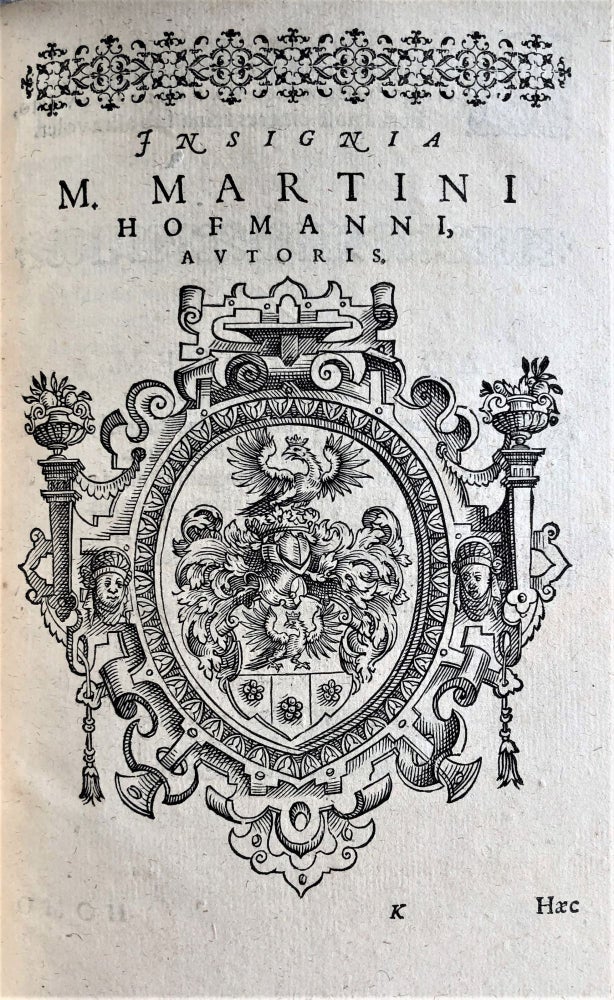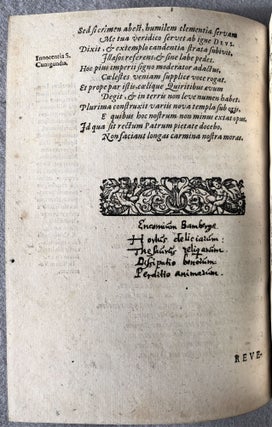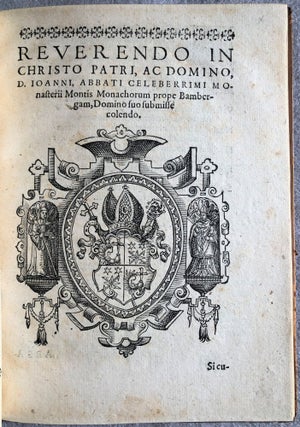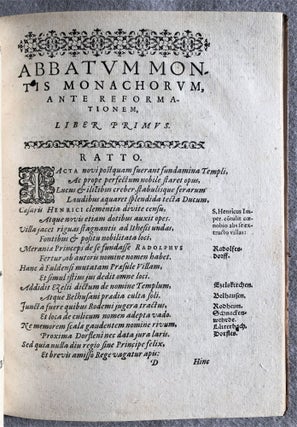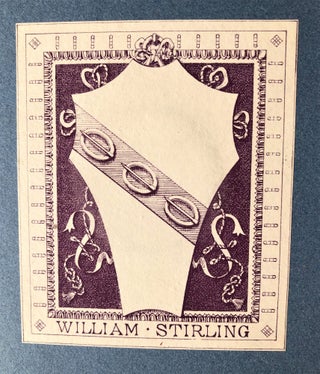Urbs Bamberga, et Abbates Montis Monachorum prope Bambergam, elegiaco versu descripti. Nuremberg: Paul Kauffmann, 1595.
4to (198 x 140 mm). Collation: A-K8. [80] pp. Italic (text) and roman types (shoulder notes and preliminary verses), a few words in gothic and greek types, three full-page woodcut coats-of-arm within ornamental borders, woodcut title ornament, head- and tail-pieces and initials, two metalcut tailpieces, type-ornament section dividers. Light spotting to first and last few leaves, overall slight discoloration. Late 19th-century English tan calf, covers with central blind-stamped circular monograms of William Stirling-Maxwell, that on front board with “Gang forward” motto, blind fillet frames, blue endpapers, by Leighton (stamp-signed on front inner board), upper cover detached. Provenance: five lines of contemporary manuscript verse on C3v; Sir William Stirling-Maxwell (1818-1878), bookplate and supra-libros.***
First Edition of a neo-Latin verse description of Bamberg and chronicle of the abbots of Bamberg’s Benedictine Abbey of St. Michael (or Michelsberg), by that city’s first historian.
Intended by Henry II, Duke of Bavaria and future Holy Roman Emperor, as the “second Rome” when in 1007 he made Bamberg the seat of a bishopric and his family seat, the city’s importance only increased after the 13th century, when it became a Prince-Bishopric, and it remained a prosperous cultural center and link toward the Slavic lands well into the Baroque period. Bamberg’s medieval architecture was influential in northern Germany and Hungary; undamaged in WWII, it is now a UNESCO World Heritage Site.
In his 18-page poem on the town, Hofmann leads the reader around his city’s streets, hills, bridges, and major buildings, providing historical background. Forty-seven abbots, of which 34 pre-Reformation and 13 post-Reformation, are memorialized in verse in the longer part of the book, from Ratto (d. 1020) to the current abbot Johann V (d. 1627). These accounts contribute a few historical details not included in Hoffman’s major work, left unfinished at his death, the Annales Bambergenses, which ended in 1440. Illustrated are the arms of the dedicatees, the reigning Prince-Bishop of Bamberg, Nithardus (Neytard von Thüngen) and the current Abbot of St. Michael, Johannes V, as well as Hofmann’s own arms, granted him by Maximilian II along with the title of Poet Laureate. The last quire contains matter usually considered introductory: a poem from the author to the reader, a philosophical poem on life (”Homo bulla”), and dedicatory verses from Christoph Girschner (or Girsner), Secretary to the Bishop, and Joannes Cyaneus, a fellow Poet Laureat.
At the end of the poem on Bamberg, a jaded reader, probably not a native Bambergian, added his own summary of the city, rich in ecclesiastical benefits and hence corruption: Encomium Bambergae / Hortus deliciarum: / Thesaurus reliquarum / Dissipatio bonorum / Perditio animarum.
I locate two copies outside Germany, at Yale and the British Library.
VD 16 H 4298; BM/STC German p. 409; cf. Flood, Poets Laureate in the Holy Roman Empire: A Bio-bibliographical Handbook (2006), H-90; Neue Deutsche Biographie 9: 459. Item #3197
Price: $4,800.00

